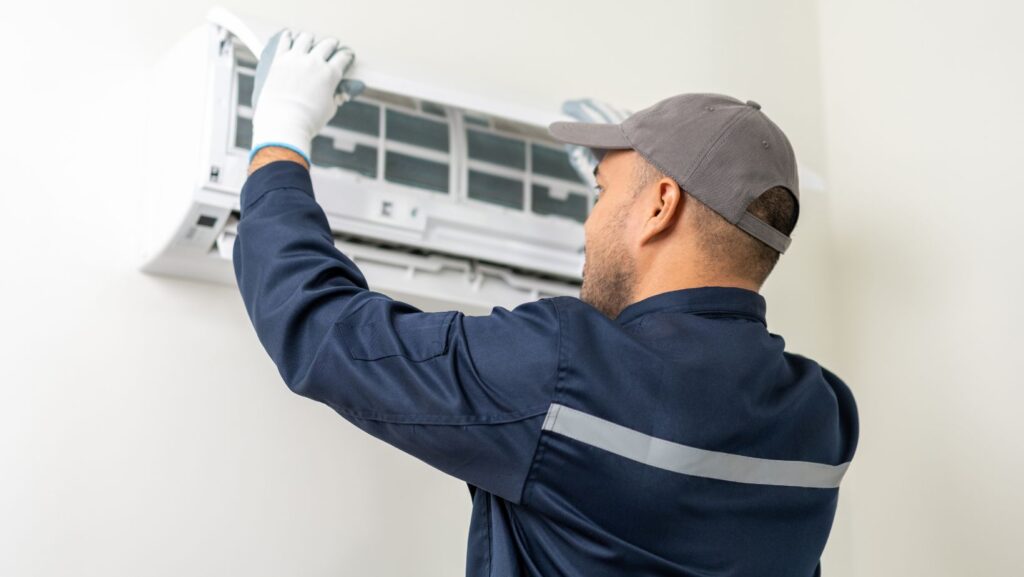Air conditioning is important for home appliances, especially on hot summer days. To make it work efficiently and for a long time, you need to set it up properly and maintain it regularly. In this article, we’ll go over the basic steps to set up and maintain the air conditioner in your home.
Choosing the Right Place to Install the Air Conditioner
Indoor Unit
– Installation height: The indoor air conditioner unit should be installed at approximately 2-2.5 meters from the floor. This will ensure that the cooled air is evenly distributed throughout the room.
– Avoid obstacles: The indoor unit should not be located near furniture or other objects that may obstruct air circulation.
– Maintenance access: Provide easy access to the indoor unit for regular maintenance and filter cleaning.
Outdoor Unit
– Ventilation: The outdoor unit must have sufficient space for free air circulation. Avoid placing the unit in an enclosed or tight place.
– Weather protection: The outdoor unit should be protected from direct sunlight and precipitation. Use special visors or covers for protection.
Setting Up the Air Conditioner Correctly
Temperature Settings
– Recommended temperature: Set the temperature to 24-26°C in summer for comfortable cooling. This will help reduce the load on the air conditioner and energy consumption.
– Operating mode: Use the automatic mode to maintain a constant room temperature. This will allow the air conditioner to adjust the fan and compressor automatically for optimal comfort.
Fan Settings
– Fan speed: Set the fan to medium or high speed to cool the room quickly. You can reduce the speed once the desired temperature is reached to maintain comfort.
– Airflow Direction: Adjust the airflow direction using the louvers to avoid direct blowing of people in the room. This will help avoid discomfort and ensure even cooling.
Regular Maintenance of the Air Conditioner
Cleaning the Filters
– Cleaning frequency: The indoor unit filters should be cleaned at least once every two weeks while the air conditioner is active. Clogged filters reduce efficiency and increase energy consumption.

– Cleaning procedure: Unplug the air conditioner, remove the filters and rinse them under running water. Dry the filters before reinstalling them.
Checking the outdoor unit
– Cleaning debris: Check the outdoor unit regularly for leaves, dust, and other debris. Use a soft brush or vacuum cleaner to clean it.
– Piping condition: Check the condition of the piping and connections for refrigerant leaks. If you find a leak, contact a service technician to repair the problem.
Professional Maintenance
– Annual Maintenance: Schedule annual air conditioner maintenance by a professional. This will help identify and fix potential problems early.
– Refrigerant level check: Have the refrigerant level checked and the system recharged if necessary during professional service.
Energy Efficiency and Savings
– Scheduling: Use the timer to automatically turn the air conditioner on and off at specified times. This will help reduce energy consumption and ensure a comfortable temperature when you return home.
– Night mode: Set the night mode to reduce the temperature and fan speed while you sleep. This will ensure a comfortable sleep and reduce the load on the air conditioner.
– Keep windows and doors closed: Keep windows and doors closed when the air conditioner is in operation to avoid losing cooled air and reduce the load on the system.
– Window and door seals: Check the window and door seals for damage and replace them if necessary. This will help reduce air leakage and improve air conditioner efficiency.
Additional Recommendations
– Voltage stabilizer: A voltage stabilizer protects the air conditioner from power surges. This will help prevent damage to electronic components.
Avoid long periods of inactivity: Use the air conditioner regularly, even when it is not needed every day. This will help prevent wear and tear on the compressor and keep the system running smoothly.
– Check the efficiency: Keep an eye on the air conditioner’s efficiency. If your air conditioner is not working as efficiently as it used to, it may be a sign that it needs maintenance or repair. Responding to such changes promptly will help to avoid serious damage.

Genuine Parts: Use only genuine parts to replace worn or damaged components. This will ensure the air conditioner’s optimal performance and preserve its warranty.
You can find the necessary spare parts for your air conditioner at applianceparts4all, which offers a wide range of home appliance parts.
Conclusion
Proper setup and regular air conditioner maintenance are key factors in ensuring its efficient and long-lasting operation. You can ensure a comfortable microclimate in your home by following simple tips on choosing a location, setting up operating modes, and regular cleaning. Don’t forget the importance of professional maintenance and timely replacement of worn parts to avoid serious breakdowns and increase the efficiency of your air conditioning system.



